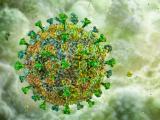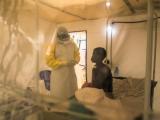Despite the recent drop in Ebola cases in West Africa's outbreak region to zero, the disease continues to make headlines outside and inside the region, with a nurse hospitalized in London with a relapsed infection and a phase 2 trial of another vaccine candidate launching in Sierra Leone.
Also, preparations for the next epidemic got a big boost this week with the announcement of $11 million in project grants from the Paul G. Allen Ebola Program, which had already pledged $100 million to help with outbreak response.
Nurse had been discharged in January
In a Scottish government statement, the country's chief medical officer, Catherine Calderwood, MBChB, said nurse Pauline Cafferkey has been transferred from Queen Elizabeth University Hospital in Glasgow to Royal Free Hospital in London after getting sick from an unusual late complication from her illness.
Cafferkey was first hospitalized for Ebola in December when she got sick after returning from working in Sierra Leone.
"This is not a new case of Ebola and is a complication of her previous illness. The risk to the public remains extremely low and all appropriate infection control measures are in place," Calderwood said.
Royal Free London today issued a statement confirming the transfer and that Cafferkey is being treated in isolation in the hospital's high-containment unit according to national guidelines.
During her first hospitalization at Royal Free London she was treated with experimental medication and convalescent serum. She recovered and was discharged Jan 24.
After survivors clear the virus from the bloodstream, Ebola can linger in immune-protected areas such as the eyes or testes. So far it's not known how long the virus can survive. The long-term effects from Ebola infections can be debilitating and include joint pain, eye problems, fatigue, and headache.
Trial of third Ebola vaccine launches
Human trials for a candidate Ebola vaccine—a prime-boost regimen spearheaded by Johnson & Johnson's Janssen Pharmaceuticals—expanded to the outbreak region for the first time, with participants in Sierra Leone receiving their first doses, the company announced today.
The prime-boost regimen uses a combination of two components based on AdVac technology from Crucell Holland BV, a Janssen subsidiary, and MVA-BN technology from Bavarian Nordic. Vaccine developers are conducting the Sierra Leone trial alongside ongoing phase 1 and 2 studies in the United States, Europe, and areas outside the outbreak region.
In a statement today, Johnson & Johnson said the Sierra Leone trial is designed to assess safety and immunogenicity and that further recruitment is under way. Patients will receive an initial AdVac dose to prime the immune system, then 2 months later the MVA-BN dose, which is intended to boost immunity and extend the duration of protection.
The trial is taking place in Bombali district, one of the hardest-hit outbreak areas and the site of some of Sierra Leone's most recent cases.
A steep decline in all three countries has made it difficult to test the clinical efficacy of vaccines and treatments. Sierra Leone hasn't reported an Ebola case since the middle of September.
An earlier ring vaccination trial of the Canadian-developed VSV-EBOV vaccine in Guinea found that it was highly effective, which led researchers to discontinue the control arm of the trial and extend the trial to neighboring Sierra Leone. Advanced clinical trials of ChAd3, developed by GlaxoSmithKline and the National Institute of Allergy and Infectious Diseases, are also under way in the outbreak region.
Duration of protection isn't yet known for the two vaccines, and some experts have said trials involving different Ebola vaccine approaches should continue, because there may be an ongoing need for vaccines that provide both immediate and long-term protection.
Peter Piot, MD, PhD, director of the London School Hygiene and Tropical Medicine, one of the groups conducting the study, said in the statement, "We cannot afford to be complacent about Ebola. We urgently need a vaccine that offers long-term protection of the population, including health workers and other caregivers, in order to prevent a resurgence of the virus." Piot helped identify the Ebola virus in 1976.
New preparedness funds
An Ebola program established by philanthropist Paul G. Allen recently announced that it has awarded seven grants totaling $11 million to groups working on projects to shore up gaps in epidemic response, such as infrastructure and logistics, data and coordination, and diagnostic tests. Allen's $100 million earlier pledge was the single largest private gift that was made for West Africa's outbreak response.
In an Oct 7 statement, the foundation said the awards are earmarked to disrupt epidemics and speed the response to health crises.
Barbara Bennett, president and chief executive officer of Vulcan, Inc, Allen's broader organization, said in the statement, "While the world cannot stop every outbreak, we can apply innovative solutions to more effectively fill the gaps and better prepare communities worldwide to quickly stamp out global health threats."
Grant recipients and their projects include:
- The National Center for Food Protection and Defense Institute at the University of Minnesota for medical supply chain mapping and assessment
- Chembio for a paper-based blood test that can distinguish between five different causes of fever, allowing Ebola to be diagnosed faster
- Becton, Dickinson and Company for an instrument-based rapid test for Ebola and other sources of fever
- Foundation for Innovative New Diagnostics for setting up field tests and preparing regulatory submissions for new diagnostic tests
- United Nations Office for the Coordination of Humanitarian Affairs for an open platform for standardizing data
- Baylor College of Medicine for a rapid, deployable four-bed Ebola treatment unit (ETU)
- World Food Program for establishing a common platform supply chain
Benefits of ETU control measures
Deploying an ETU and lab in an outbreak setting can significantly improve many response markers, according to a study conducted in Sierra Leone's Bombali district. Researchers from the US Centers for Disease Control and Prevention (CDC) and their collaborators from Sierra Leone and other African nations reported their findings today in Morbidity and Mortality Weekly Report (MMWR).
The first ETU and lab came online in Bombai district in late November and early December, and the researchers' goal was to gauge epidemiologic indicators before and after the facilities began operating. They were able to analyze the variables from an Ebola database managed by the Bombali surveillance team.
The investigators found, for example, that the interval between symptom onset and lab result dropped from 7.3 days to 5.2 days after ETU and lab implementation, and the gap between specimen collection and lab results decreased from 2.5 days to 1.2 days. Other gaps that narrowed included patient isolation to lab result, symptom onset to case investigation, and symptom onset to patient isolation.
The researchers concluded that ETUs and labs, when combined with other well-known control measures, have the potential to stem a rapid increase in the number of Ebola cases and that emergency response planning could benefit from prepositioning resources to speed the deployment of treatment and lab units.
See also:
Oct 9 Scottish government statement
Oct 9 Royal Free London statement
Oct 9 Johnson & Johnson statement
Oct 7 Allen Foundation statement
Oct 9 MMWR report

















